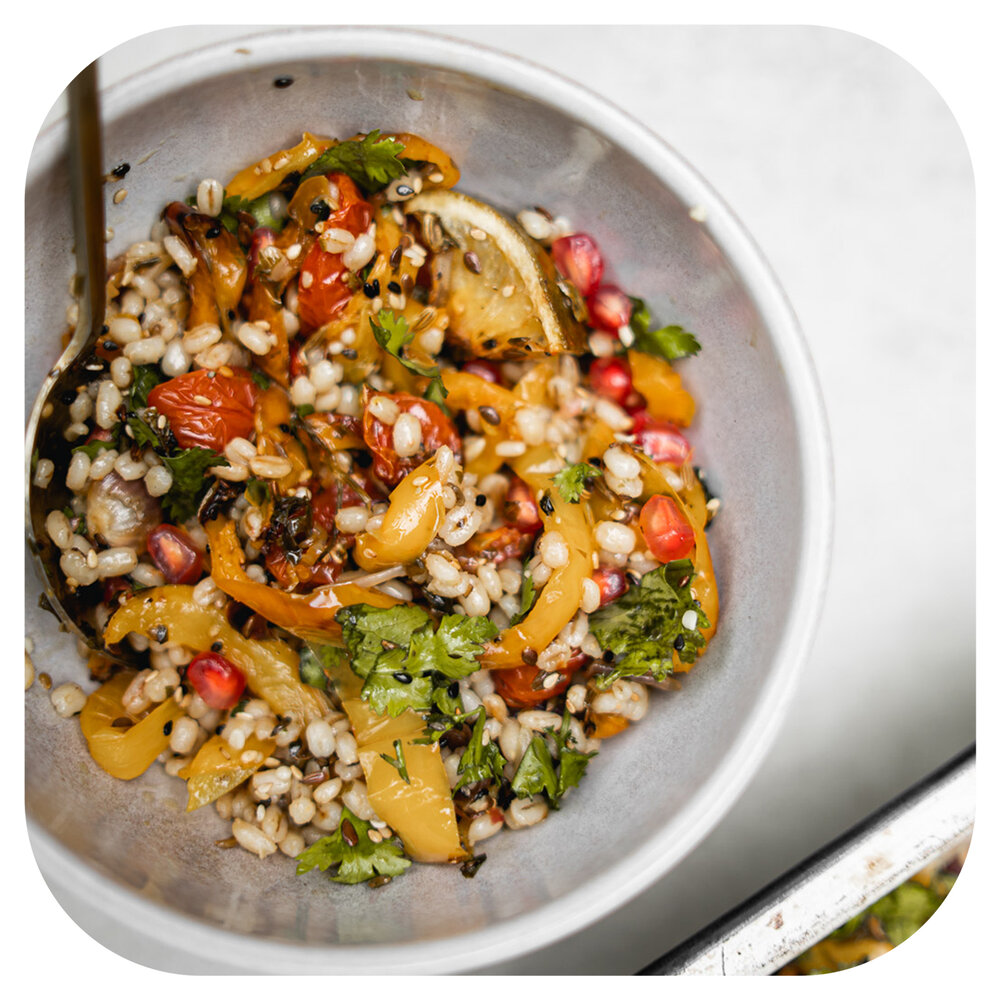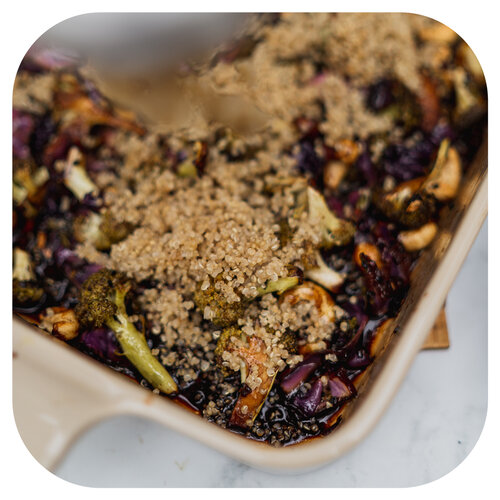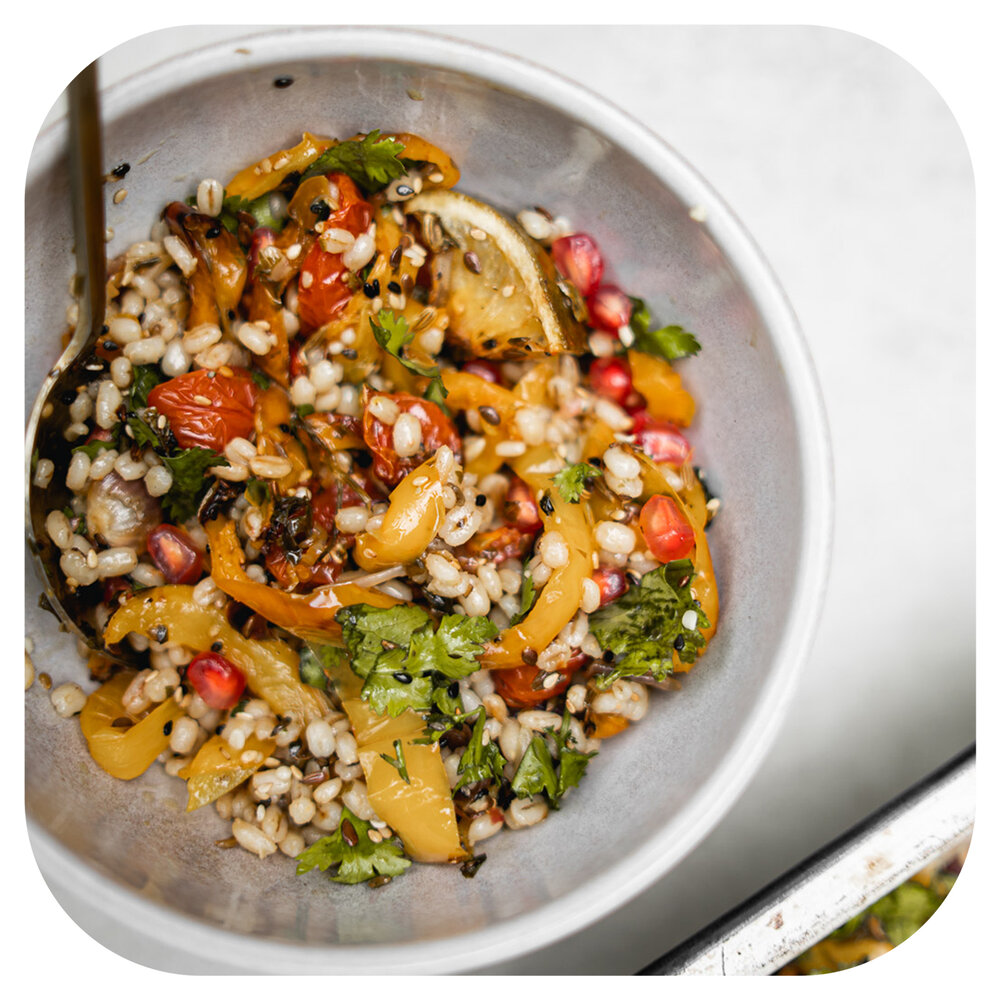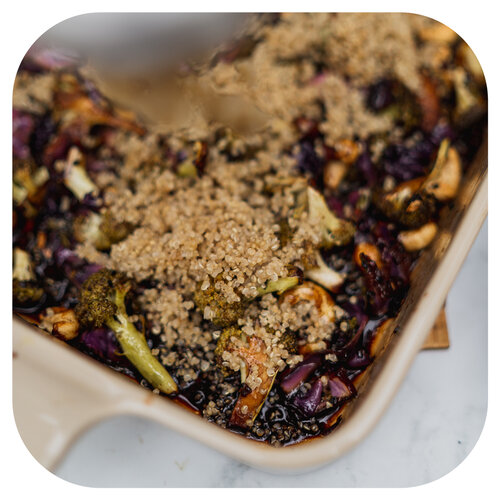What do we mean when we talk about grains?

Rice, wheat, sorgum, and barley are considered grains. Millets and quinoa are pseudograins- they look and act like grains in many ways but are actually seeds and have varying nutritional profiles.
What is the difference between whole grains & refined grains?
All grains are originally whole grains in their natural state, they essentially make up the entire seed of the plant. This seed is made up of the bran, germ and the endosperm. The process of refining strips the grains of this nutritious outer layer. A refined grain refers to a grain that is not whole as it is devoid of one or more of the three key parts (germ, bran or endosperm).
This is a problem because the bran is rich in magnesium, zinc, iron, riboflavin, niacin, phosphorous and thiamine. Bran is also an excellent source of fibre which prolongs digestion, keeps blood sugar levels stable and keeps you feeling full for longer periods of time. Which are all good things.
White rice and white flour (maida) are examples of refined grains where both the germ and the bran have been removed. Refining a grain removes about a quarter of the protein and half to two thirds of a number of nutrients.
Whole grains are grains where the three parts are in tact- as nature intended. They contain a number of valuable vitamins, minerals, fibre and phytochemicals that promote digestion and maintain the health of your intestines.
What are the health benefits of eating whole grains?
Fibre is a key reason as to why you should switch to whole grains. The recommended dosage of fibre is between 25-35gm/day, which research has shown most people don’t reach. Whole grains contain both soluble and insoluble fibre which are both beneficial. Fibre tends to digest slowly, hence when you eat fibre-rich foods you feel fuller for longer periods of time.
Let’s talk a little more about fibre: fibre increases the bulk of waste material that is passing through the digestive system. Basically, it is essential for healthy, satisfying bowel movements and reducing constipation. Fibre is also crucial to creating and maintaining a healthy gut microbiome.
A number of studies have found that eating whole grains resulted in a lower consumption of calories and reduced systemic inflammation. In contrast, excessive consumption of refined grains have been associated with elevated inflammatory markers in the blood.
Whole grains are an important source of a number of B vitamins, which include thiamin, niacin, folate and riboflavin. The dietary fibre found in whole grains has been found to help in reducing cholesterol levels and may even lower the risk of diabetes, heart disease and obesity.
What are the problems with refined grains?

Conversely, when it comes to refined grains, most of the nutrients and the fibre has been removed making them a carbohydrate source with a high glycemic index. Consumption of refined grains has been linked to diseases such as diabetes, obesity and heart disease. Due to the low fibre content of these grains they can be digested quickly and hence can cause huge fluctuations in blood sugar levels which often leads to overeating. Most of us have experienced a short-lived sustenance after eating refined grains like a big pile of biryani; so much so that you can eat another junk food meal within 2 hours of eating the first meal! This is because high GI (glycemic index) foods promote a feeling of short-term fullness, whereas low GI foods such as whole grains promote a feeling of sustained fullness which lasts considerably longer.
Consumption of excess sugar and refined grains (white rice, maida, white bread etc) has been found to result in chronic, low-grade inflammation (for more information on inflammation read this post by Hannah) that has been known to cause a number of diseases such as diabetes, cancer, heart disease etc. In comparison whole grains contain fibre, antioxidants and certain phytochemicals that can regulate blood sugar and protect against systemic inflammation.
Hopefully this article has explained why switching to whole grains is important! Read on for practical tips and swaps to get more of the goodness of whole grains into your life.
8 simple tips for incorporating more whole grains into your daily eating habits
It’s important to gradually transition to whole grains. Your body may not be used to a whole lot of fibre which can cause you to experience some bloating. If you’ve tried to switch to whole grains before, you may have gone too much, too soon. Start by eating small portions of whole grains at first, perhaps just a few spoons of brown rice alongside slightly less rice for example, and increasing the quantity gradually week by week.
Drink lots of water on a daily basis; a minimum of 2.0- 2.2 litres/day and likely more, depending on your energy expenditure and the temperature outside. Drinking enough water aids in digesting complex carbohydrates and fibre-rich foods..
If you enjoy cereals for breakfast, always opt for whole grains with a high bran content like rolled or steel cut oats, ragi, buckwheat, millet and bran cereal. Learn to be discerning when you read ingredient labels- many products like mass-produced bread and cereals which describe themselves as whole or multigrain have a very small percentage of whole grains- the rest is made up of refined grains. Don’t be tricked by bread that looks brown, it may be coloured with molasses or caramel. A great breakfast option that incorporates whole grains is our overnight oats recipe- which uses rolled oats, soaked in almond milk or coconut milk and is topped with seasonal fruits and nuts.
For South Indian breakfasts, experiment with making your own dosa and idli batters at home using whole grains and different dals, rather than store-bought packaged options. It’s cheaper, and you have the chance to incorporate a wide variety of different grains such as ragi, brown or red rice, millet varieties as well as varied dals and spices.
Swap regular white rice for whole grains like brown rice, millet, amaranth, quinoa, buckwheat etc that have not been polished. You can cook and eat these whole grains just like rice- alongside a curry or sabzi. Or try experimenting with salads and grain bowls- our 7 steps to a really great salad will help you to create something delicious and nutritious!
Soak whole grains for at least half an hour before cooking- and 2-4 hours is possible. This helps to reduce cooking time as well as making them easier to digest.
Swap your white flour (maida) with whole grains like whole wheat flour, ragi, buckwheat flour whenever you’re cooking or making rotis. You can also replace maida with whole grain flours when baking muffins, cakes, pancakes and cookies. You could start by replacing 3/4th of the flour with whole grain flour and increase the amount slowly.
Make simple swaps such as 100 % wholewheat bread and pasta over their white counterparts whenever available.


